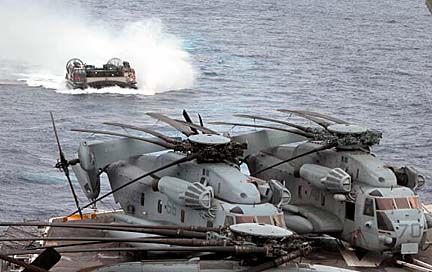
GREGG K. KAKESAKO / GKAKESAKO@STARBULLETIN.COM
An air-cushioned landing craft approached the USS Boxer 10 miles south of Oahu after it completed a practice run last week. The Boxer carries three of these types of craft, which can carry a 60- to 75-ton payload of weapons systems to shore.
Ship models new
response planThe USS Boxer is in the Mideast
after just a few months home
Like many island young adults, 19-year-old Werner Kamaunu joined the Navy two years ago shortly after graduating high school to travel.
War wasn't on his mind.
"I wanted to see the world," the Waipahu High graduate said last week in the wardroom of the USS Boxer as the amphibious assault ship headed back to the Persian Gulf. "This is such a small rock and it's hard to get off."
On March 19, Kamaunu, a mess specialist, was flown to the Boxer just as airstrikes were launched against Iraq.
"There were a lot of things going on," he said. "We had to worry about chemical attacks. There were days when nothing was going, and then there were others that were filled with flight drills."
The 840-foot Boxer returned to San Diego in July after a 6 1/2-month deployment, but in November it was recalled to sea as part of the largest U.S. military combat movement since World War II. The majority of its crew embarked on a second wartime cruise within a span of one year.
However, this time the Boxer is merely serving as a military ferry, carrying 16 Marine Corps CH-53 Super Stallion helicopters, equipment, maintenance personnel, air crew members and only 200 Marines. Normally, the Boxer is outfitted with 1,200 Marines, six Harrier jets, 23 helicopters, and three landing craft and vessels. More than 21,000 Marines, some of whom may come from Kaneohe to be part of the 110,000-member rotational force, will be flown to Iraq to replace Army troops who have been there for more than a year.
Capt. Tom Crowley, Boxer's skipper, said the change helps keep both the Marines and their equipment in a higher state of readiness.
On the Atlantic coast, the USS Bataan, Boxer's sister ship, left Norfolk, Va., on Monday on its fourth deployment in four years, on a similar resupply mission. Both the Bataan and Boxer carry a crew of 900 sailors.
The Boxer and the Bataan's quick turnaround come as the Navy begins to implement a new strategy -- called the "Fleet Response Plan" by its planners -- which is designed for sudden "surge" operations after maintenance to cope with the ongoing war on terrorism.
This means that Navy warships have to be fully manned well before deployment dates, unlike in years past, which saw a rapid buildup in manning just before ships deployed.
In the past, the Boxer, after completing a six-month deployment, would spend the next 12 to 18 months in port upgrading its equipment and getting structural repairs while its crew was replaced or underwent further training. A ship could lose up to a third of its crew after a six-month deployment.
Adm. Walter Doran, Pacific Fleet commander, said in a July speech that the plan will give the Pentagon the flexibility to have six carrier battle groups ready to go anywhere within a 30-day notice.
"It doesn't mean they will go for a six-month deployment at that time," Doran said. "It will be much more going and coming back. Go, do the job and come home."
Doran said the Navy is considering using the USS Stennis carrier battle group next year to test the concept, incorporating the biennial RIMPAC exercise here as part of the preparation.
The Navy said the Boxer's current deployment is not officially part of this readiness program.
However, Crowley and other crew members realize that it is a preview of what is to come. Crowley said the change was easy because of the high level of maintenance and combat training the ship started as soon as it returned to San Diego last summer.
"Four years ago, we couldn't have done this," Crowley said.
Master Chief Jerry Galbiso, a 24-year veteran, said the change may result in "us being at sea for only three months or so at a time, rather than six or eight months as it has been in the past."
"We may not deploy that often," said Galbiso, a 1977 Waialua High School graduate.
Petty Officer Isaac Santiago, 25, a 1996 Nanakuli High School graduate, said his wife, Trisha, was "more shocked" than he was when, after being home for nearly 170 days, he was ordered back to sea.
"She got over it -- after she cried a lot," Santiago said.
But Santiago said his wife always knew what he wanted to do before they got married.
"I like sea duty," said Santiago, who is on his third deployment. "I told my wife before we got married, 'I'm in the Navy and I want to be at sea.'"
